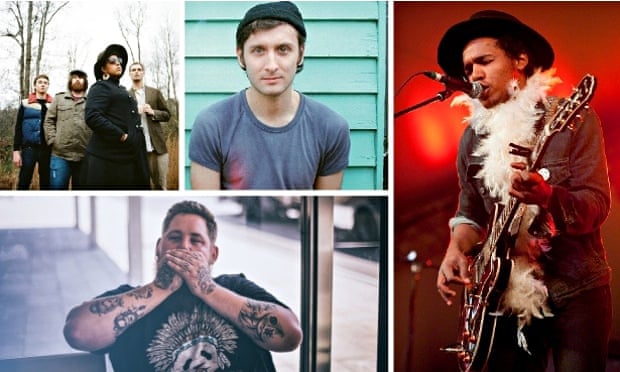‘A little punk, a little jazz, a little shoegaze’: meet the new blues
From the spirituals of the deep south to the White Stripes, it’s a music that has constantly reimagined itself. But is anyone really ready for EDM blues?

Since its inception in the American south in the early years of the 20th century, the blues has been repeatedly rethought, redreamed, restructured and re-presented; from the early blues WC Handy heard played in a Tutwiler railway station, to the female blues singers such as Mamie Smith and Ma Rainey in the 1920s, the Delta blues of Robert Johnson, and the electric blues of T-Bone Walker, and on to the British blues of the 50s and 60s that brought Alexis Korner, Led Zeppelin, the Rolling Stones and Eric Clapton, as well as more recent incarnations, led by the White Stripes and the Black Keys. It has spun out from spirituals and slave plantations, crossed gender, race, class, states, rivers and oceans, and been played in juke joints, cellar bars, concert halls and stadiums. But where does it now stand, and where is it headed?
In the summer of 2010, Jim Fusilli, the rock and pop critic for the Wall Street Journal, travelled to the 31st Blues Foundation annual gala in Memphis, and his resulting report sounded puzzled and somewhat disappointed: “I heard folk blues, country blues, jump blues, Chicago blues, Delta blues, Texas blues, fast blues, slow blues, good blues and bad blues,” he wrote. “What I didn’t hear was new blues.” Fusilli wondered what the future of the genre might be, and like Turner, considered the possibility of the blues rethought: “Young fans who still fuel the music marketplace may admire veterans like Mr [Buddy] Guy, but they’re right to ask if there’s a new way to play the blues, one that’s affiliated with new sounds and styles.”
As Fusilli found, there exists an uneasy situation in the blues world – on the one hand stands a core fanbase savouring the more traditional forms of the blues, and on the other presses the need for a genre to remain vital rather than simply preserved.
In recent times, the blues has begun to twist and turn once again, with a raft of new artists embracing and embroidering the form. Where the blues of the White Stripes was sparse and pared-back, the latest take seems fuller, more elaborate. Consider, for example, Rag’N’Bone Man’s melding of hip-hop and blues, the rootsy blues-rock of Alabama Shakes or the twisted desert blues of DD Dumbo.
Benjamin Booker released his debut album on Rough Trade earlier this year. Twenty-five years old, a Florida native transplanted to New Orleans, Booker cites the influence of the Gun Club and T Rex as much as Blind Willie Johnson, and was led to the blues by more contemporary artists. “If I liked a band, I tried to find out who they would listen to,” he explains. “So the White Stripes were big when I was a kid, and Nirvana did a cover of Where Did You Sleep Last Night?, which is how I found Lead Belly’s music.”
The difference between Booker’s music and that of the White Stripes or the Black Keys is, he suggests, simply generational: “When Jack White was looking at the blues he was combining it with what he listened to when he was growing up – he had people like the Gun Club, who I’ve only more recently started getting into. So what he listened to growing up was different to what I listened to growing up, but every music takes something from blues. If you listen to the Jesus and Mary Chain, there’s soul in there. If you listen to any of the old blues guys there’s a lot of innuendo and whatever in there — it’s the same as rap, but 80 years before.”
“I loved the fact that he was as immersed in modern music as he was the country blues,” says Geoff Travis, founder of Rough Trade Records, the label that signed Booker, and before him the Alabama Shakes. “I thought the music was thrilling and the voice seemed to convey something heartfelt. That is somewhat rare. It did no harm that he reminded us of Jimi Hendrix a little, in the way he uses feedback and moves on stage sometimes. Also the beat was right, unrelenting, and danceable. Why can’t we dance to modern rock’n’roll very often?
“What is the new twist?” he continues. “Maybe the filter and knowledge of punk and blues-inspired punk. This is a different route than the way the Stones got there, Jimmy Rogers and Muddy Waters being twin pillars. Just two examples of many, but Chuck Berry is in common and of course Otis Redding and the whole school of southern soul. But talent comes in to it, too. People aren’t simply the sum of their influences and upbringing and culture. The Alabama Shakes and Benjamin have the talent to stake a claim that few people actually do.”
Australian musician Oliver Perry, recording under the stage name of DD Dumbo, is another young artist who is leading the blues somewhere new. Using guitar, voice and Tanzanian ilimba, his music is looped and reverbed and droned to create a sound that marries African desert blues and Tuvan melody, and has as much in common with the work of Tune-Yards as Booker.
Speaking from Australia, Perry talks about his love for Ali Farka Touré, Howlin’ Wolf and Lightnin’ Hopkins’ style of guitar: “I feel he’s understanding lead lines, that I might do something similar, naturally,” he says. “It feels soulful in a particular way.”
Earlier this year an artist named Rag’N’Bone Man released a cover of House of the Rising Sun. A traditional folk song made famous by the Animals, it tells of a life gone awry in New Orleans. Rag’N’Bone Man’s version was named simply Rising Sun and revealed a quaking, belly-deep voice that also featured the Newcastle rapper Stig of the Dump. Rag’N’Bone Man is Rory Graham, raised in Brighton, not the Bayou, but introduced to the world of the blues via his parents’ record collection. “I would flick through them,” Graham says, “and a couple of records stood out – John Lee Hooker and J J Cale. It’s quite difficult to explain, but I think certain people are drawn to certain sounds.” At the same time he was discovering hip-hop, and realising the productions weren’t all that dissimilar.
As a performer, Graham was drawn to the physical sensation of singing the blues. “I can’t think and sing at the same time,” he says. “I close my eyes and that’s the only thing. Whatever your view of the blues, whether you’re a purist or not, it’s a magnet. It draws you in because it’s the blueprint for music, for everything, even the pop you hear in the charts. So it’s no wonder people go back to it.”
Wearing influences easily is part of the blues tradition – this is a genre in which whole songs, verses, lines and refrains are recycled and remade, in which performers have reinvented themselves, remodeled their music and their show to ape another. Booker talks of how he is equally influenced by garage rock bands and blues musicians: “Charley Patton throwing his guitar up in the air and catching it. Robert Johnson turning away from the audience to play. I mean these guys were definite showmen, showing up in town and trying to get an audience.”
Meanwhile Geoff Travis refers to “Jack White’s almost vaudevillian country blues artifice in his vocal mimicry, something I really like, but you smile at the pantomime. Listen to Son House, for example. We now know that blues artists were themselves not above singing the popular songs of the day and mimicking the vaudeville heroes and heroines themselves.”
But for some, the issue of authenticity does niggle. “I have a very particular take on things,” says Janice Monti, professor of sociology at Dominican University in Illinois, and director of the Blues and Spirit Symposium. “I’ve been arguing for a long time that the blues has been jacked. Most [new blues musicians] are white males, American, European, Australian – and that’s not to take away at all from the talent and the innovation of these young people, but there is this little-addressed but important issue: if we’re looking at blues legacy, blues aesthetic, it’s a history of a legacy of oppression, but also a black aesthetic.
“Blues is celebrated, but there are no black people at the party. That kind of colour blindness results in yet another blues revival that almost exclusively ignores and marginalises black artists. White males are predominant. The black artists are not there. It’s reflective of a false postracial mentality that it’s whites who are the ones who are innovating. Who gets to tell the story? And what story are they telling? It’s interesting to me that this salient cultural product, which is the backbone of all popular music, has been so disrespected.”
Booker, an African-American, is certainly aware of his heritage – he talks of Blind Willie Johnson and Furry Lewis, of how “it was so refreshing to hear just one man and a guitar, to have black men, in the 20s and 30s, putting themselves out there in a way that I can’t even imagine it.”
The writer James Baldwin is also important to Booker, Travis says. “So there is something going on there with an understanding of the underbelly of American black culture and for its need for self-determination, respect and civil rights,” he explains. “But it is not earnest and over-serious and preachy, it is incandescent and disruptive. But it gives Benjamin some substance that makes him different from the Black Keys.”
But for Booker, the predominant force is music – whether it is black or white, punk or country blues, and a musician’s right to mingle them all together if she or he sees fit. I ask him what the most preposterous potential blues hybrid might be and he thinks for a moment then laughs down the line. “Blues and EDM, maybe?” he says. “I don’t even want to think about that … But that might be cool, you never know – it might even get EDM kids listening to the blues.”
DD Dumbo’s Tropical Oceans EP is out now on 4AD. Benjamin Booker’s self-titled debut album is out now on Rough Trade. Rag’N’Bone man’s album Wolves is out now digitally on Columbia and via Bandcamp.

No comments:
Post a Comment